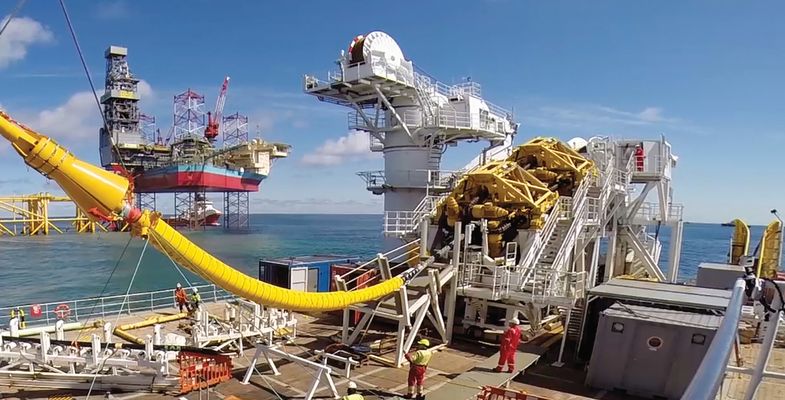IEEE 48 Subsea Cable Termination Testing
The IEEE Standard 48 covers tests and requirements for the termination of submarine cables. This standard is crucial in ensuring the reliability, safety, and long-term performance of subsea cable terminations used in offshore energy production facilities. Offshore platforms and subsea cables are integral to modern renewable energy projects such as wind farms, deep-water oil drilling rigs, and underwater power transmission systems.
Subsea cable termination testing is a critical aspect of the design, installation, and maintenance processes for these installations. The IEEE 48 standard provides specific requirements that ensure all terminations meet stringent performance criteria under various environmental conditions. This includes tests to verify water tightness, mechanical strength, electrical insulation integrity, and thermal stability.
In practice, termination testing involves a series of comprehensive checks on the cable’s end connections to ensure they are fit for purpose in marine environments. These tests typically include hydrostatic pressure testing to simulate ocean pressures at various depths, saltwater immersion tests, and mechanical stress tests simulating potential stresses from waves and currents.
For quality assurance, compliance with IEEE 48 ensures that the terminations can withstand harsh conditions without compromising on performance or reliability. The standard also provides guidelines for acceptance criteria which must be met to pass these tests successfully. This includes precise measurements of electrical resistance, voltage breakdown strength, and moisture ingress.
The testing process is highly technical and involves specialized equipment capable of simulating the extreme pressures and temperatures found in deep-sea environments. The results from these tests are critical for quality managers and compliance officers to ensure that all offshore installations comply with international standards and are fit for purpose.
Compliance with IEEE 48 is not just about meeting regulatory requirements but also about ensuring the safety and longevity of subsea cable systems. By adhering to this standard, R&D engineers can design more robust termination systems that can withstand the rigors of marine environments while maintaining high levels of performance.
For procurement teams, IEEE 48 compliance is essential in selecting suppliers who provide terminations capable of withstanding the specific environmental challenges they face. This ensures that the chosen components are reliable and will perform consistently over time, reducing the risk of costly failures or downtime during operations.
Industry Applications
The IEEE 48 subsea cable termination testing is particularly relevant for several sectors within the energy industry. Offshore wind farms, deep-water oil drilling rigs, and underwater power transmission systems all benefit from this standard.
- Offshore Wind Farms: The harsh marine environment poses significant challenges to subsea cable terminations used in wind turbines located far from shore. Termination testing ensures that these components can withstand the corrosive effects of saltwater and the mechanical stresses caused by wave action.
- Deep-Water Oil Drilling Rigs: In deep-water drilling, subsea cables are crucial for communication between the surface rig and underwater equipment. Testing to IEEE 48 ensures that these cables can operate reliably in extreme conditions while also protecting against potential failures that could lead to significant operational disruptions.
- Underwater Power Transmission Systems: These systems require robust terminations capable of transmitting power across long distances under water. Compliance with IEEE 48 helps ensure the integrity and performance of these critical infrastructure components, supporting reliable electricity supply in remote areas.
The standard’s emphasis on durability, reliability, and safety makes it a vital component of modern renewable energy projects. By adhering to IEEE 48, organizations can enhance their operational efficiency while minimizing risks associated with subsea cable failures.
Why Choose This Test
- Enhanced Reliability: Compliance with IEEE 48 ensures that subsea cable terminations are tested to withstand the harshest marine conditions, reducing the risk of failure.
- Compliance with International Standards: Adhering to this standard guarantees that all components meet international safety and performance criteria, ensuring regulatory compliance.
- Prolonged Operational Lifespan: Rigorous testing helps identify potential weaknesses early on, allowing for timely repairs or replacements before they lead to costly downtime.
- Enhanced Safety: By ensuring that terminations are robust enough to handle extreme conditions, this test minimizes the risk of accidents and injuries.
The IEEE 48 standard provides a comprehensive framework for testing subsea cable terminations. This ensures not only compliance with international regulations but also enhances reliability, longevity, and safety in marine environments. Organizations that adopt this standard can benefit from reduced maintenance costs, improved operational efficiency, and increased confidence in their equipment.
Quality and Reliability Assurance
- Testing Procedures: The IEEE 48 standard outlines specific procedures for testing subsea cable terminations. These include hydrostatic pressure tests to ensure the termination can withstand deep-sea pressures, saltwater immersion tests to check resistance to corrosion, and mechanical stress tests to evaluate durability.
- Acceptance Criteria: The standard sets clear acceptance criteria that must be met for a termination to pass testing successfully. These include precise measurements of electrical resistance, voltage breakdown strength, and moisture ingress limits.
The testing process is designed to simulate real-world conditions as closely as possible. This ensures that terminations are not only laboratory-tested but also proven capable of performing reliably in their intended environments. The detailed acceptance criteria provide a robust framework for quality assurance, ensuring that all subsea cable terminations meet the highest standards.
By adhering to IEEE 48, organizations can ensure that their subsea cables and associated terminations are fit for purpose, reducing the risk of failures and maintaining optimal performance over time. This standard is a cornerstone in the ongoing effort to improve safety and reliability in offshore energy installations.





